As you step into your home, the captivating leaves of a Calathea plant catch your eye, their vibrant hues and fascinating movements instantly drawing you in. These tropical beauties, also known as prayer plants, possess a unique charm that can transform any indoor space into a lush, serene oasis. Whether you’re a seasoned plant parent or a budding gardener, this complete care guide will equip you with the knowledge and confidence to cultivate a thriving Calathea that will bring joy and life to your personal haven.
Table of Contents
Introduction to Calathea Plants
Calathea plants, often referred to as “prayer plants,” are a captivating genus known for their distinctive leaf patterns and their unique ability to fold their leaves at night, resembling hands in prayer. These tropical beauties hail from the lush rainforests of South America and have become beloved houseplants for their visual appeal and air-purifying properties.
What Makes Calathea Unique?
The distinctive feature of Calathea plants is their prayer plant movement, where the leaves rise up at night and lower during the day. This remarkable behavior is a response to changes in light, allowing the plants to optimize their exposure and protect their delicate foliage. Calathea’s vibrant, patterned leaves come in a wide range of colors and designs, making them a visually stunning addition to any indoor space.
Popular Calathea Varieties
- Calathea orbifolia: Large, round leaves with striking silver-green patterns
- Calathea medallion: Oval leaves with a dark green center and bright pink or red undersides
- Calathea lancifolia (Rattlesnake Plant): Narrow, elongated leaves with dark green stripes
- Calathea ornata (Pinstripe Plant): Leaves with alternating dark green and light green stripes
- Calathea lutea (Cigar Plant): Large, paddle-shaped leaves with a distinct vein pattern
- Calathea zebrina (Zebra Plant): Oval leaves with bold, dark green zebra-like stripes
- Calathea roseopicta (Rose-Painted Calathea): Leaves with a pink or red central pattern
Each Calathea variety offers a unique and visually captivating foliage display, making them a popular choice for calathea care enthusiasts and plant enthusiasts alike.
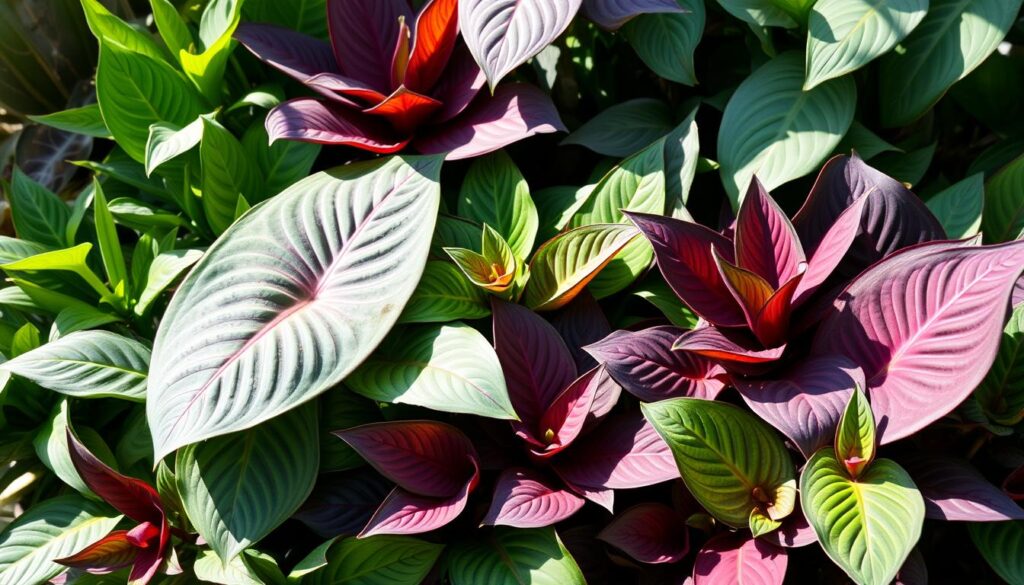
Ideal Growing Conditions for Calathea
Cultivating a thriving Calathea plant requires specific environmental conditions that mimic their natural tropical habitat. From temperature and humidity requirements to the perfect soil blend and light preferences, understanding these details is crucial for ensuring your Calathea’s long-term health and vibrant foliage.
Temperature and Humidity Requirements
Calathea plants thrive in warm, humid environments. The ideal temperature range for these tropical beauties falls between 65°F and 80°F (18°C – 27°C). To maintain optimal humidity levels, aim for 50% to 70% relative humidity. This can be achieved by regularly misting the plant, using a pebble tray, or placing the Calathea in a naturally humid room, such as a bathroom.
Best Soil Type for Calathea
Calathea plants prefer a well-draining, slightly acidic soil mix. A combination of potting soil, peat, and perlite or orchid bark is an excellent choice, as it provides the necessary moisture retention and aeration for these thirsty plants. Avoid letting the soil become overly compacted or soggy, as this can lead to root rot and other issues.
Light Preferences
When it comes to lighting, Calathea plants thrive in indirect, bright light. Avoid exposing them to direct sunlight, as this can cause the vibrant leaf patterns to fade and potentially lead to leaf burn. Ideal locations for a Calathea include north or east-facing windows, where they can enjoy the filtered, gentle light that keeps their colors vivid and their growth lush.
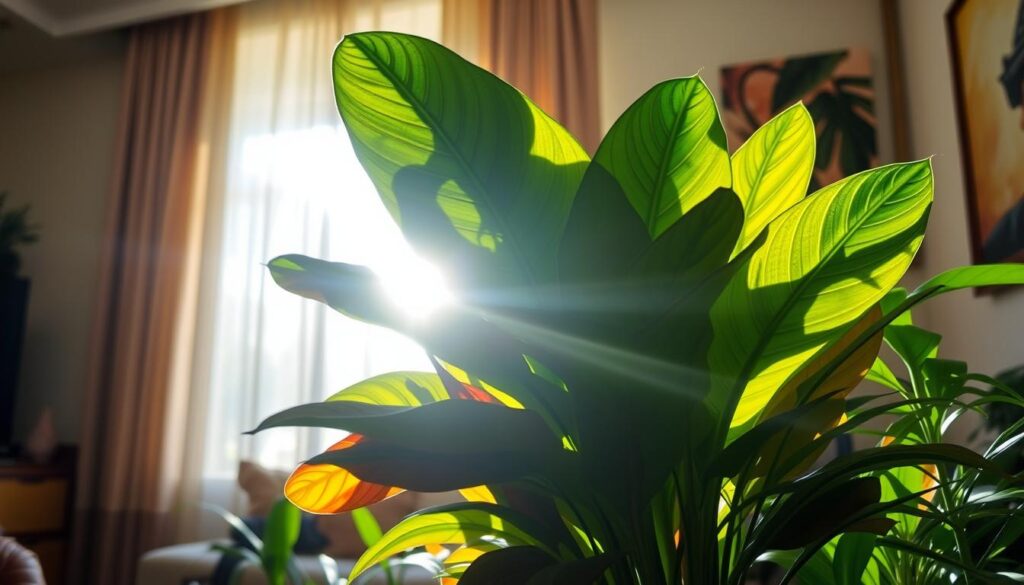
“Calathea plants are known for their stunning, intricate leaf patterns, and providing them with the right growing conditions is key to maintaining their beauty.”
Watering Your Calathea
Maintaining the right balance of moisture is crucial for your Calathea’s health. These plants prefer consistently moist, but not soggy, soil. The key is to water thoroughly when the top inch of soil feels dry to the touch.
How Often to Water
The frequency of watering will vary depending on the season and your specific growing conditions. During the warmer months, you may need to water your Calathea more frequently, as the soil will dry out faster. Aim to water your plant every 7-10 days, adjusting as needed based on the soil moisture level.
It’s important to use filtered or distilled water for your Calathea, as they are sensitive to the chemicals and minerals found in tap water. This will help prevent issues like browning leaf edges and other water-related problems.
Signs of Overwatering vs. Underwatering
- Overwatering: Yellowing leaves, wilting, and root rot are all signs of overwatering. If the soil remains constantly moist, it’s time to adjust your watering schedule.
- Underwatering: Wilting, curling, and crunchy leaves indicate that your Calathea is not getting enough water. When the soil is completely dry, it’s time to water thoroughly.
To ensure proper drainage and prevent waterlogging, make sure your Calathea is planted in a pot with adequate drainage holes. This will help the soil dry out between waterings and keep the roots healthy.
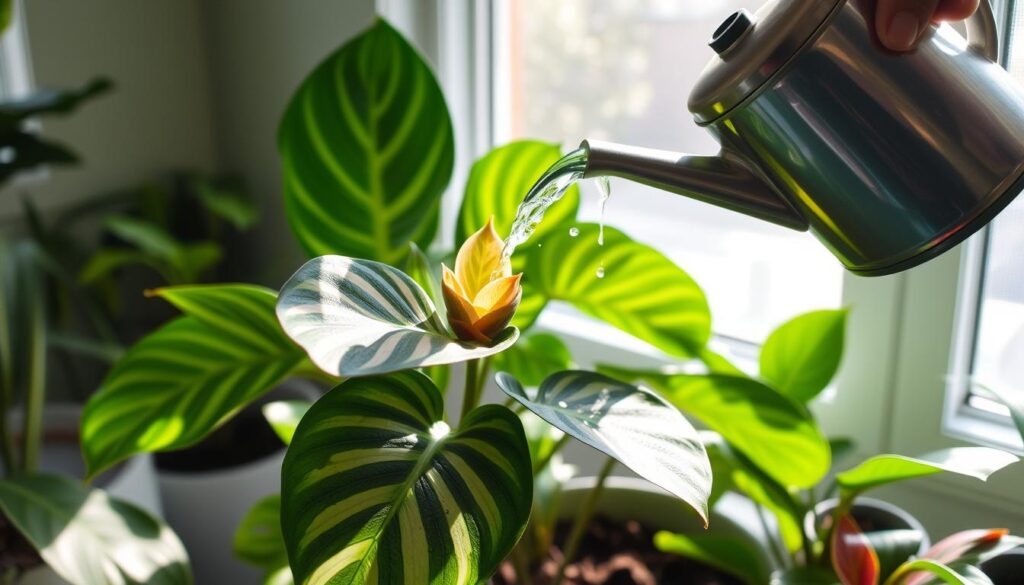
“Proper watering is the key to a thriving Calathea. Consistency and using the right water are essential for these plants to truly flourish.”
Fertilizing Calathea Plants
Proper fertilization is crucial for keeping your calathea plants thriving and lush. These tropical beauties require a balanced diet of essential plant nutrients to support their growth and vibrant foliage.
Best Fertilizers for Growth
Choose a water-soluble, balanced calathea fertilizer with an equal ratio of nitrogen, phosphorus, and potassium (such as a 10-10-10 or 20-20-20 formula). These formulas provide a comprehensive blend of nutrients to nourish your calathea plants and promote healthy leaf development.
Frequency of Fertilization
- Fertilize your calathea plants every 4-6 weeks during the active growing season (spring and summer).
- Apply the fertilizer at half the recommended strength to avoid over-feeding and potential leaf burn.
- Avoid fertilizing during the fall and winter months when growth naturally slows down.
It’s important to monitor your calathea plants and adjust the feeding schedule as needed. Occasional soil flushing can help remove any excess salts that may build up from over-fertilization.
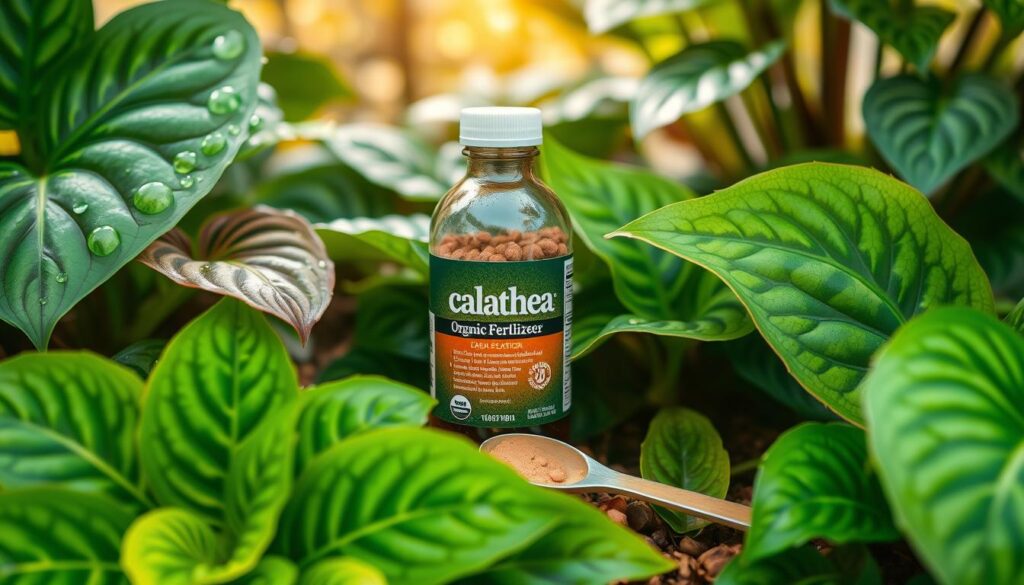
“Proper fertilization is key to maintaining the vibrant, lush foliage of your calathea plants.”
By following a balanced calathea fertilizer regimen, you can ensure your plants receive the essential plant nutrients they need to thrive and bring a touch of tropical beauty to your indoor space.
Pruning and Grooming Your Calathea
Maintaining the beauty and health of your calathea plant requires regular pruning and grooming. By following these simple steps, you can ensure your calathea continues to thrive and showcase its vibrant, eye-catching foliage.
When to Prune
Prune your calathea plant as needed, typically during the active growing season in spring and summer. Look for any damaged, yellowing, or dying leaves and carefully trim them off at the base of the stem using clean, sharp scissors or pruning shears. Removing these unsightly leaves promotes healthy new growth and helps your calathea maintain its desired shape.
Best Pruning Techniques
- Use clean, sharp scissors or pruning shears to make clean cuts and avoid damaging the plant.
- Carefully inspect the leaves and stems, identifying any areas that need trimming.
- Cut leaves and stems just above the soil line or at the base of the plant.
- Avoid cutting more than one-third of the plant’s foliage at a time to prevent stress.
- Disinfect your pruning tools before and after use to prevent the spread of any diseases.
In addition to pruning, regular grooming of your calathea plant is essential. Gently wipe the leaves with a damp cloth to remove any accumulated dust or debris. This not only enhances the plant’s appearance but also ensures proper light absorption for optimal photosynthesis.
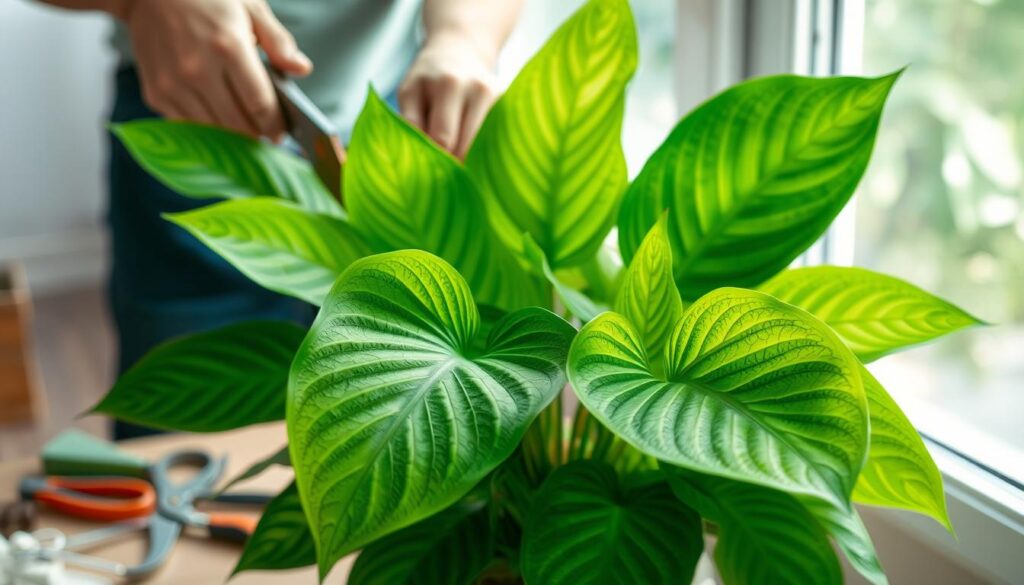
By incorporating these calathea pruning and plant grooming techniques into your routine, you’ll be rewarded with a lush, leaf care-focused calathea that adds a touch of tropical elegance to your indoor space.
Pest and Disease Management
Maintaining the health and vigor of your calathea plants requires vigilance when it comes to pest and disease control. From common pests like spider mites, mealybugs, and scale insects to potential diseases such as leaf spot and root rot, being proactive is key to keeping your calathea thriving.
Common Pests Affecting Calathea
Spider mites, mealybugs, and scale insects are some of the most frequent pests that can plague calathea plants. These tiny invaders feed on the leaves and stems, causing discoloration, stunted growth, and even plant death if left unchecked. To combat these pests, consider using insecticidal soap or neem oil, both of which are effective and eco-friendly solutions.
Treating Calathea Diseases
Diseases like leaf spot and root rot can be a concern for calathea growers, often arising from overwatering or poor air circulation. To prevent these issues, maintain proper watering habits, ensure adequate air flow around your plants, and avoid overcrowding. If you do notice signs of disease, promptly remove affected leaves and treat the plant with an appropriate fungicide as needed.
By staying vigilant and addressing pest and disease problems promptly, you can keep your calathea plants healthy and thriving for years to come. With the right care and attention, these beautiful foliage plants will reward you with lush, vibrant growth.
“Proper pest and disease management is essential for the long-term success of your calathea plants.”
Propagating Calathea
Propagating your Calathea plants is a fantastic way to multiply their beauty and share your green thumb with others. The division method is the preferred technique for successfully propagating these striking tropical plants.
Methods of Propagation
Calathea propagation is typically done through division rather than cuttings. This is best performed during the plant’s repotting in the spring, when it’s in its active growth phase. Gently separate the root ball, ensuring each division has a good number of healthy roots and leaves. Plant each division in its own pot filled with a well-draining, nutrient-rich potting mix.
Tips for Successful Growth
- Maintain high humidity levels, ideally between 50-70%, for the newly propagated Calathea plants.
- Keep the soil consistently moist, but not waterlogged, to support the establishment of the divided plants.
- Avoid fertilizing immediately after propagation to allow the plants to focus on root development and settling into their new containers.
- Provide bright, indirect light and protect the young Calatheas from direct sun exposure, which can damage their delicate leaves.
By following these simple propagation techniques and providing the right growing conditions, you can easily multiply your Calathea collection and share the joy of these stunning calathea propagation with your family and friends.
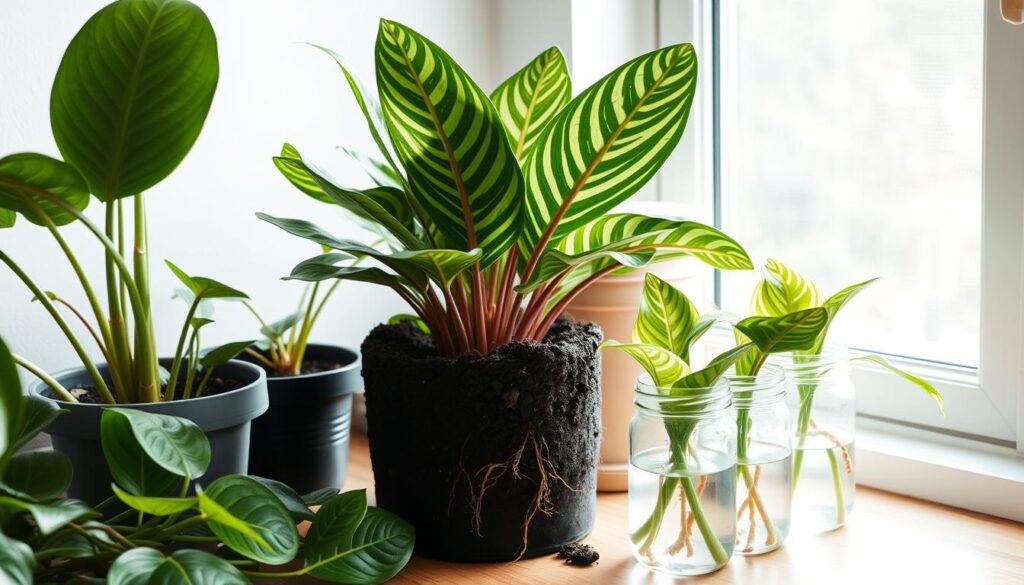
Troubleshooting Common Issues
As captivating as Calathea plants are, even the most dedicated plant enthusiasts may encounter a few challenges in their care. Two of the most common issues faced with these tropical beauties are leaf curling and browning, as well as droopy or wilting leaves. By understanding the underlying causes and taking the right steps, you can address these problems and keep your Calathea thriving.
Leaf Curling and Browning
Leaf curling in Calathea plants is often a sign of low humidity. These plants hail from tropical regions and thrive in environments with 50-70% humidity. If the air is too dry, the leaves may start to curl inward to conserve moisture. Additionally, brown or crispy leaf edges can indicate that the plant is not receiving enough humidity or is being exposed to chemicals in tap water.
To remedy this issue, try increasing the humidity around your Calathea. You can mist the leaves regularly, use a pebble tray, or invest in a compact humidifier like the Roeskm Ultrasonic Humidifier. Additionally, consider using filtered or distilled water instead of tap water, as the former contains fewer minerals that can damage the delicate leaves.
Droopy or Wilting Leaves
Drooping or wilting leaves on a Calathea plant can be a sign of either over-watering or under-watering. These plants prefer consistently moist, but not waterlogged, soil. If the soil stays too wet for too long, the roots may start to rot, leading to a wilted appearance. Conversely, if the soil dries out too much between waterings, the leaves will begin to droop.
To address this problem, conduct a touch test by checking the soil moisture about a knuckle deep. Water your Calathea when the top two inches of soil feel dry, being careful not to let the soil become completely parched. Proper drainage is also crucial to prevent issues like root rot, so ensure your plant is in a well-draining potting mix and has a container with adequate drainage holes.
By understanding the common Calathea problems and taking the appropriate actions, you can help your plant thrive and maintain its stunning foliage. With the right care, your Calathea will continue to be a beautiful addition to your indoor oasis.
Conclusion: Enjoy Your Calathea Journey
Successful calathea care requires attention to detail and mimicking tropical conditions. Maintain consistent warmth, indirect light, and high humidity for thriving plants. Rotate the plant occasionally for even growth, and be patient as Calatheas can be sensitive to environmental changes.
Final Tips for Calathea Care
With proper care, these stunning plants will reward you with their breathtaking foliage and unique leaf movements, bringing a touch of the tropics to your indoor space. Remember to monitor soil moisture, adjust lighting as needed, and provide the right balance of nutrients to ensure your indoor plant success. By following these guidelines, you’ll be well on your way to becoming a confident tropical plant enthusiast.
Share Your Calathea Success Stories
Whether you’re a seasoned plant parent or new to the world of Calatheas, we’d love to hear about your journey. Share your Calathea success stories and tips with the community, inspiring others to dive into the captivating world of these unique and vibrant houseplants.
FAQ
What makes Calathea plants unique?
Calathea plants, also known as prayer plants, are prized for their striking foliage and unique leaf movements. They can fold their leaves at night, resembling hands in prayer.
What are some popular Calathea varieties?
Popular Calathea varieties include Calathea orbifolia, Calathea medallion, Calathea lancifolia (Rattlesnake Plant), Calathea ornata (Pinstripe Plant), Calathea lutea (Cigar Plant), Calathea zebrina (Zebra Plant), and Calathea roseopicta (Rose-Painted Calathea).
What are the ideal temperature and humidity requirements for Calathea plants?
Calatheas thrive in temperatures between 65°F and 80°F (18°C – 27°C) and high humidity levels of 50% to 70%.
What type of soil is best for Calathea plants?
Calatheas prefer well-draining, slightly acidic soil mix containing potting soil, peat, and perlite or orchid bark.
How much light do Calathea plants need?
Calatheas grow best in indirect light and should be kept away from direct sunlight, as it can cause leaf burn and fade the vibrant patterns.
How often should I water Calathea plants?
Water Calatheas thoroughly when the top inch of soil feels dry. Adjust watering frequency based on seasons, with more frequent watering during warmer months.
What are the signs of overwatering and underwatering Calathea plants?
Signs of overwatering include yellowing leaves and root rot, while underwatering can cause wilting and leaf curling.
How often should I fertilize Calathea plants?
Fertilize Calathea plants every 4-6 weeks during the growing season (spring and summer) using a balanced, water-soluble fertilizer at half strength.
How do I prune and groom Calathea plants?
Prune Calathea plants as needed to remove damaged or yellowing leaves, using clean, sharp scissors. Gently wipe dust from leaves with a damp cloth to maintain their vibrant appearance.
What are common pests and diseases that affect Calathea plants?
Common pests include spider mites, mealybugs, and scale insects, while diseases like leaf spot and root rot can occur due to overwatering or poor air circulation.
How do I propagate Calathea plants?
Propagate Calathea plants through division during repotting in spring. Gently separate the root ball and plant each division in its own pot with fresh soil.
What are some common issues with Calathea plants?
Common issues include leaf curling, browning edges, and wilting, often due to low humidity, underwatering, or environmental stress.

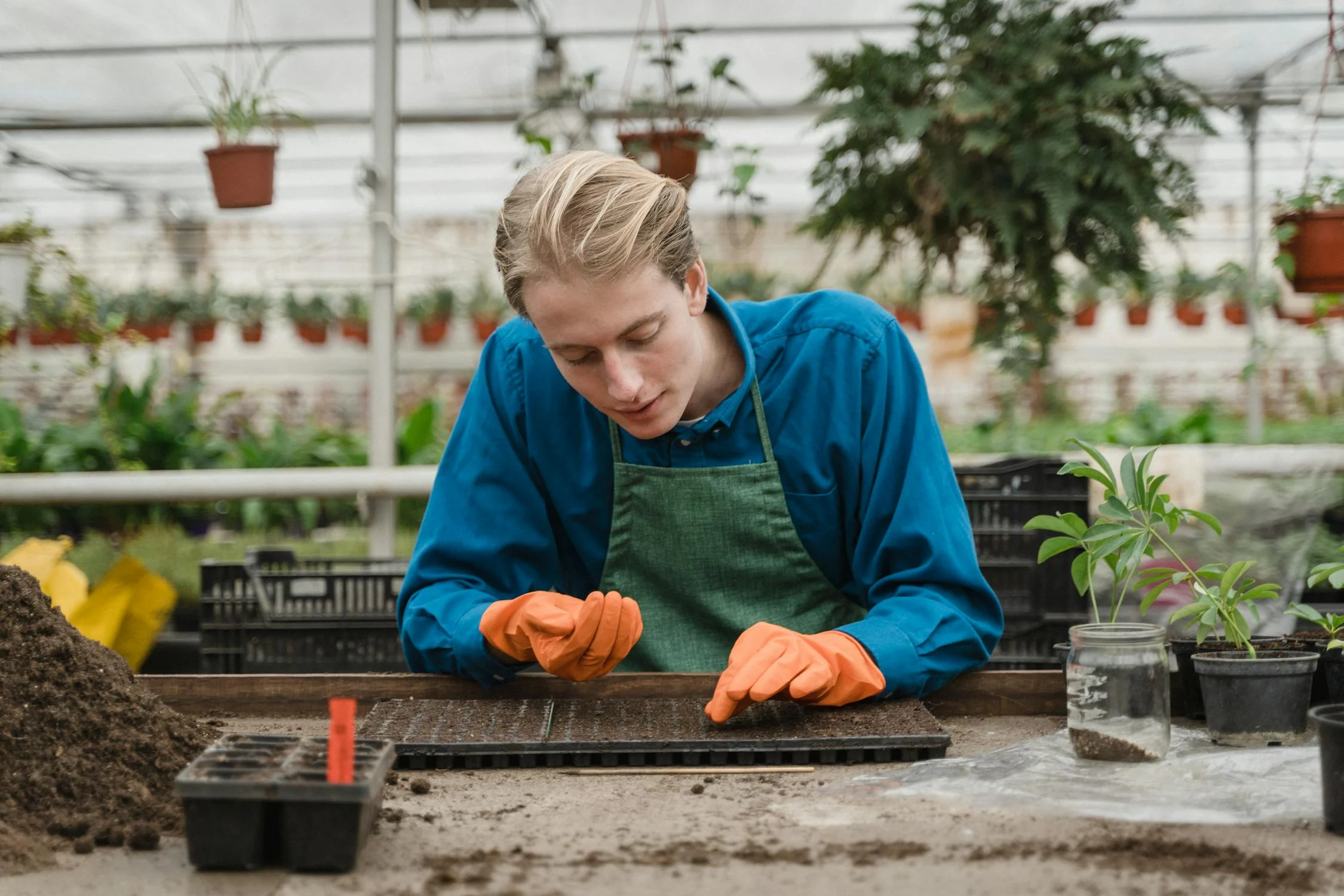
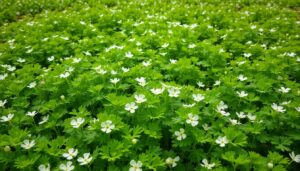








1 thought on “Grow a Beautiful Calathea Plant: Complete Care Guide”